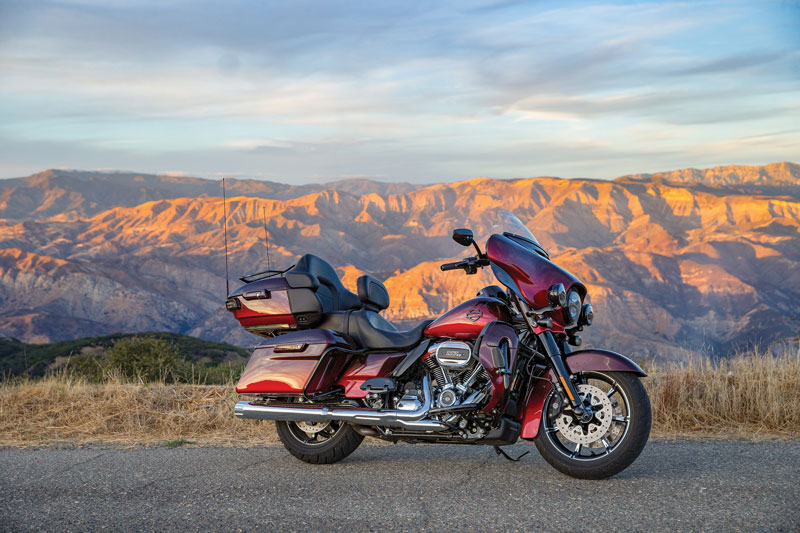2018 Harley-Davidson CVO Limited

Road Test Review
Back in 1999, when there was worldwide worry about computers failing because of the Y2K glitch, Harley-Davidson launched the Custom Vehicle Operations (CVO) program. Those were the days when Harley’s stock price was rocketing toward the moon and demand for its motorcycles outstripped supply, motivating some dealers to sell bikes far above MSRP and buyers to flip new bikes for profit. The idea behind the CVO program was to build small batches of coveted factory customs, exclusive models that would fetch exclusive prices.
With production limited to just 900 units each, the first two CVO models were cruisers, the FXR2 and FXR3, with special paint jobs and “an abundance of chrome,” bikes that were “designed to not only fulfill the dreams of motorcycle customizers, but to inspire them.” Even though Harley-Davidson introduced its new 1,442cc Twin Cam 88 V-twin on Dyna and Touring models in 1999, the inaugural CVOs were powered by the older-tech 1,340cc Evolution V-twin.
The following year CVO began producing models with hot-rodded engines, starting with the Screamin’ Eagle Road Glide and its 1,550cc Twin Cam 95. As the program evolved, the number of CVO models offered each year increased from two to four, and the limited-production runs became less limited, multiplying from 1,800 in 1999 to more than 14,000 in 2015. (CVO production has since been dialed back, with about 6,000 units for the 2018 model year.)
With the all-new Softails hogging the cruiser spotlight, Harley’s Custom Vehicle Operations group rolled out a Touring-only lineup for 2018: CVO Street Glide ($39,949), CVO Road Glide ($41,399), CVO Limited ($42,949) and 115th Anniversary CVO Limited ($43,949). Yes, those dollar signs are followed by big numbers. In the case of the CVO Limited tested here, it costs $15,950 more than a standard Ultra Limited in Vivid Black ($26,999). What does that extra dough get you? A lot, actually.
Bragging rights start with what’s between your legs, and this year all CVO models boast the largest, most powerful stock engine ever offered by Harley-Davidson: a 117ci (1,923cc) Twin-Cooled Milwaukee-Eight with special cam timing and a claimed 125 lb-ft of torque—10 percent more than the standard 107ci engine on Touring models. Setting the CVO 117 apart from other Harley V-twins is an exclusive orange finish on the rocker box lowers, which matches the black-over-orange bar-and-shield logo that stands in high relief on the gas tank. There’s also a wish list of accessory upgrades, everything from the blacked-out Airflow Collection (grips, controls, floorboards and highway pegs) and Contrast Chrome Slicer wheels to a Hammock heated touring seat with rider and passenger backrests, power saddlebag and trunk locks, a tire-pressure monitoring system and a pair of wireless headsets with an interface module.
What really sets CVOs apart from the herd is their paint and finishes. According to Harley’s VP of Styling and Design, Brad Richards, who had very big shoes to fill when he took over for Willie G. Davidson, “When it comes to CVOs, we sweat the details.” A CVO needs to convey a premium, desirable quality whether you see it ride past on the street, walk around it at a bike night or get down on your knees and inspect it up close. Every surface and fastener is considered, from gauge faces to contrast stitching on the seat to exhaust tips. With the CVO program approaching its 20th anniversary, Richards and his design team decided the time had come to take styling in a new direction. Replacing the in-your-face colors and dramatic graphics of the past is a more toned-down palette. For the first time there are three distinct paint/finish schemes for each model, ranging from a bold, bright look aimed at older, more affluent “core” CVO customers (but still not as “loud and proud” as before) to a more contemporary, understated look geared toward younger, performance-oriented riders. As Richards describes it, the 2018 CVO lineup reflects “the current trend in design, which is to ‘walk softly and carry a big stick.’ By pulling back, we actually give the bikes more presence.”
In addition to the 115 Anniversary edition, with its solid Odyssey Blue “de-saturated” finish and anniversary graphics, the CVO Limited is offered in two top-to-bottom fade paint jobs. Our CVO Limited test bike transitions from dark Burgundy Cherry Sunglo on top to lighter Molten Red Sunglo down below, creating the illusion that it’s lit from underneath, and the rest of the bike has a mix of chrome and black finishes. The other option is darker and more subtle, with Black Earth fading into Nebula Silver and everything else blacked-out. Getting the fade just right on different body panels was technically difficult—“hard to do, hard to copy,” as Richards puts it—which reflects the degree of extra effort that goes into making CVOs special. These new-generation CVOs also have subtle branding. The only places you’ll see the name “Harley-Davidson” are below the infotainment touchscreen on the dash and embossed on the back of the Tour-Pak’s luggage rack. Elsewhere there are simple bar-and-shield outlines and a handful of small Custom Vehicle Operations logos.
When EIC Tuttle asked me to test the CVO Limited, I grabbed its black-and-chrome key fob eagerly. I love big-engine, big-boned touring bikes. Tempt me with a family-size bucket of finger-lickin’, arm-straightenin’ torque. Spoil me with plush two-up seating, benevolent wind protection and kitchen-sink luggage capacity. Indulge me with an audio system, navigation, heated grips and seats, cruise control, anti-lock brakes, a big gas tank and more. Yes, please, thank you.
Since the CVO Limited is Harley’s ultimate two-up touring bike, my wife Carrie and I loaded up the saddlebags and Tour-Pak (with 133 liters of capacity, we had room to spare), donned our Boom! Audio 20S EVO Bluetooth headset-equipped helmets and ventured into the mountains for the weekend. We had perfect weather, with crisp, clear, sunny autumn days. I settled into the deep cradle of the Hammock seat, which uses an internal sling to suspend the rider and two inches of dual-density foam above the seat pan, and Carrie nestled herself into the wrap-around backrest, both of us with our feet up on floorboards. As we ascended State Route 33 to 5,160-foot Pine Mountain Summit, the temperature dropped into the upper 40s, so I closed the fairing-lower vents and turned on the grip and seat heaters. We cruised along at a moderate, unrushed pace, savoring the scenery and our bubble of comfort.
Soaking wet, the CVO Limited weighs 940 pounds—it’s one of the heaviest bikes we’ve tested—and fully loaded we used every bit of its 420 pounds of load capacity. That’s a lot of mass to move through time and space, but the 117ci Milwaukee-Eight did so without breaking a sweat. On Jett Tuning’s rear-wheel dyno, it belted out 111 lb-ft of torque at 3,600 rpm (more than 100 lb-ft are on tap from 2,100 to 4,900 rpm) and 96 horsepower at 4,900 rpm. Throttle response is immediate and there’s pulling power everywhere. The Milwaukee-Eight is a fine example of internal combustion, providing just the right amount of rumble and report, never offensive, though fury can be unleashed with a downshift and a handful of throttle. Harley’s 6-speed Cruise Drive transmission shifts authoritatively, but it’s clunky in lower gears, neutral can be elusive and the clutch requires a strong pull.
Like all Touring models, the CVO Limited is equipped with Showa suspension front and rear, with a non-adjustable dual bending valve fork and a pair of emulsion rear shocks with a remote preload adjuster. Before our trip, I dialed in the right amount of preload and on smooth pavement we enjoyed a comfortable ride. But the best views are on the least trafficked roads, and those are the ones for which maintenance is often deferred. As we ascended tight, narrow roads in the Sierra foothills just days before their winter closure, cracks and seams became more common and suspension compliance became less forgiving. After a while, especially when Carrie felt the need to sit forward so the backrest wouldn’t jolt her in the spine, it became unforgivable.
Steering the CVO Limited, with its heavy batwing fairing (which houses the infotainment system and speakers) mounted onto the handlebars, requires effort and the front end feels disconnected from the rest of the chassis. There’s a decent amount of cornering clearance and the linked Brembo brakes are gorilla strong, but the bike prefers graceful curves just as much as smooth pavement. Overall wind protection and seat comfort are top-notch, but the windscreen is not adjustable; I enjoyed relatively smooth, quiet airflow, but Carrie struggled with helmet buffeting.
A motorcycle as premium as the CVO Limited creates high expectations, and after living with it for a month and putting close to 2,000 miles on it, for the most part it has delivered. It fulfills the desire of owning a top-of-the-line custom motorcycle for those who have the money but not the time, inclination or patience to do it themselves. Hands down the CVO Limited is the most beautiful motorcycle I’ve ever ridden, and its torque-rich V-twin, fit-and-finish, creature comforts and touring capability have won me over. But, relative to other luxury touring bikes we’ve tested, its handling, chassis dynamics and suspension compliance fall short. Over the past few years the Touring platform upon which the CVO Limited is based has come a long way, especially with the Milwaukee-Eight engine and Showa suspension that were introduced last year. But the steel frame that holds it all together hasn’t changed since 2009. Touring models have gotten heavier and more sophisticated, and—as with the new Softails—they need a chassis that can keep up. Also, especially at an ultra-premium price point like this, more rear suspension travel and the magic-carpet ride that comes with electronic semi-active suspension would elevate the riding experience. Because that’s the thing about beautiful motorcycles—we should derive as much pleasure riding them as we do looking at them.
